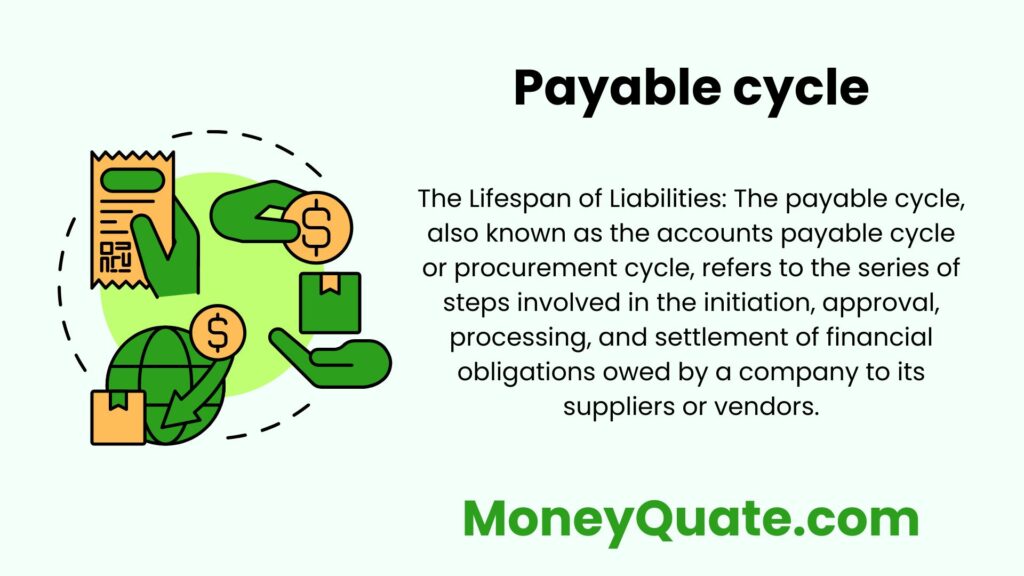The payable cycle, also known as the accounts payable cycle or the payables turnover cycle, refers to the time it takes for a company to pay its suppliers for goods or services purchased on credit. It involves the entire process from the receipt of the invoice from the supplier to the payment of the invoice by the company.

Contents
Components of the Payable Cycle:
Invoice Receipt
The payable cycle kicks off with the receipt of an invoice from a supplier, detailing the goods or services provided.
Example: A manufacturing company receives an invoice from a raw material supplier for a recent bulk purchase.
Invoice Verification and Approval
The invoice undergoes scrutiny, verifying accuracy against purchase orders, contracts, and quality standards. Approval processes may involve multiple departments or individuals.
Example: A procurement manager reviews the invoice, checks it against the received goods, and obtains necessary approvals.
Recording in the Accounts Payable
Once verified and approved, the invoice amount is recorded as a liability in the accounts payable ledger.
Example: The approved invoice amount is added to the accounts payable ledger, acknowledging the company’s obligation to the supplier.
Payment Processing
Payment terms are considered, including due dates, early payment discounts, and penalties for late payment. The company schedules payments accordingly.
Example: If the payment terms are “Net 30,” the company plans to make the payment within 30 days of the invoice date.
Payment Execution
On or before the due date, the company initiates the payment using various methods such as checks, electronic transfers, or online platforms.
Example: The finance team processes a batch payment, ensuring all approved invoices are settled within the stipulated time-frame.
Reconciliation
Post-payment, the accounts payable ledger is updated to reflect the payment, and reconciliation ensures accuracy.
Example: The finance department reconciles the accounts payable ledger with bank statements to confirm that the payments match the corresponding invoices.
Importance of Managing the Payable Cycle:
Cash Flow Management
Efficient payable cycle management optimizes cash flow by balancing timely payments with maintaining sufficient liquidity.
Example: A company strategically schedule payments to avoid unnecessary strain on its cash reserves.
Supplier Relationships
Timely payments foster positive relationships, leading to potential benefits such as favorable terms, discounts, or extended credit.
Example: A prompt payment history encourages suppliers to offer better terms, enhancing overall procurement efficiency.
Working Capital Optimization
Effective payable cycle management contributes to working capital optimization by aligning payment timing with cash inflows and outflows.
Example: An organization strategically plans its payable cycle to avoid unnecessary tying up of funds in accounts payable.
Cost Reduction
Streamlining the payable cycle reduces administrative costs associated with processing invoices, payments, and potential late payment penalties.
Example: Implementing automated invoicing systems reduces manual processing costs.
Strategies for Improving the Payable Cycle
Automating Processes
Implementing accounts payable automation software to streamline invoice processing, approval workflows, and payment scheduling.
Example: An e-commerce company utilizes automated systems to process supplier invoices swiftly and accurately.
Negotiating Favorable Terms
Negotiating extended payment terms with suppliers to enhance cash flow and reduce reliance on short-term financing.
Example: A construction firm negotiates with its equipment suppliers for extended payment terms.
Vendor Management
Building strong relationships with vendors, fostering open communication, and addressing issues promptly.
Example: A retail chain maintains regular communication with suppliers to address supply chain challenges proactively.
Cash Flow Forecasting
Utilizing cash flow forecasting tools to predict cash requirements and optimize payment timing.
Example: A technology company employs forecasting software to anticipate cash needs and aligns payment schedules accordingly.
Monitoring and Performance Measurement
Payables Turnover Ratio
Calculating the payables turnover ratio to assess how efficiently the company pays its suppliers. It is calculated by dividing total purchases by the average accounts payable balance.
Example: A manufacturing firm regularly evaluates its payables turnover ratio to gauge payment efficiency.
Aging of Accounts Payable
Analyzing the aging schedule of accounts payable to identify outstanding invoices and prioritize payments based on their due dates.
Example: An accounting team reviews the aging schedule to address overdue payments promptly.
Days Payable Outstanding (DPO)
Monitoring the Days Payable Outstanding metric to assess the average number of days it takes the company to pay its suppliers. It is calculated by dividing accounts payable by the average daily purchases.
Example: A finance department uses DPO as a key performance indicator to optimize payment cycles.
Conclusion
Effectively managing the payable cycle is paramount for financial health, supplier relationships, and overall operational efficiency. By understanding its components, implementing strategic measures, and employing performance metrics, companies can navigate the payable cycle successfully and contribute to their long-term financial sustainability.
2 thoughts on “The ABCs of Accounts Payable: Best Practices and Insights”